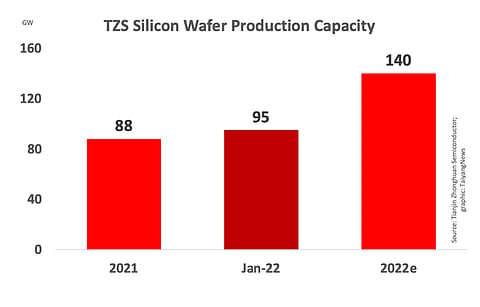

One of the world's largest solar wafer producers, Tianjin Zhonghuan Semiconductor (TZS) of China increased its annual silicon wafer production capacity to a total of 95 GW at the end of January 2022, increasing it up from 88 GW it reported at the end of 2021.
Of the 95 GW capacity, G12 production alone accounts for about 72% share. Management shared that the company's solar-grade monocrystalline silicon material smart factory in Ningxia Yinchuan with a 50 GW annual capacity, successfully produced its 1st G12 monocrystalline silicon wafer on January 17, 2022. It added that the project is progressing smoothly and various production as well as construction works are being accelerated.
As the 50 GW Yinchuan capacity comes online, by the end of 2022 it expects wafer capacity to further expand to a cumulative of more than 140 GW with G12 production representing about 90% share. In comparison, its biggest competitor, LONGi Green Energy has grown its monocrystalline silicon wafer production capacity to 105 GW till 2021-end, and plans to expand it to 150 GW by 2022-end.
It is also building a smart factory of high-purity ultra-thin monocrystalline silicon with 30 GW annual capacity which will further enhance its G12 production.
At the end of 2021, TZS' operating income improved 115.70% to RMB 41.10 billion, with net profit of RMB 4.43 billion which went up 200.58% on annual basis.
During Q1/2022, TZS reported its operating income of RMB 13.368 billion having increased 79.13% from the previous year, while net profit increased 142.08% to RMB 1.3 billion.
The management sees production uncertainties and logistical challenges increasing in the supply chain in the short term due to COVID-19 as operational challenges have intensified.
"Through the long-term construction of Industry 4.0 manufacturing capabilities, the company uses the 210 technology innovation platform to continuously improve differentiated production," it stated. "At the same time, it cooperates with downstream customers to establish a flexible marketing model to reduce transaction costs and continue to alleviate downstream customer costs. The pressure has better ensured the increase of the company's production and sales scale and the competitiveness of itself and its customers."
Citing technological advantages of 210 wafer size, TZS shared that the 600W+ PV Open Innovation Ecological Alliance saw its membership increase to more than 90 at the end of 2021. A founding group of 39 solar PV companies came together in 2020 to work on building products, systems and standards for next-generation technology platform 'committing to maximize the customer values of 600W+ ultra-high power modules and other related solutions at the application end' (see 39 PV Firms Back 600 W+ Solar PV Modules).
